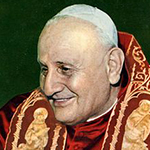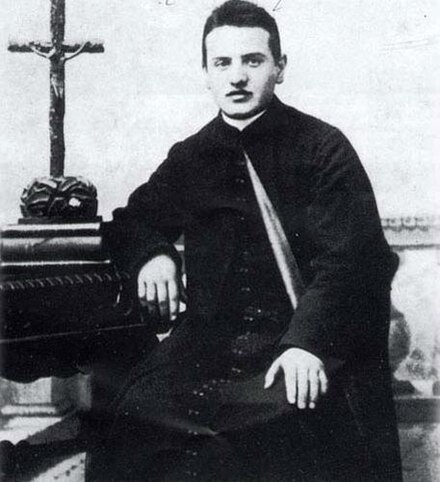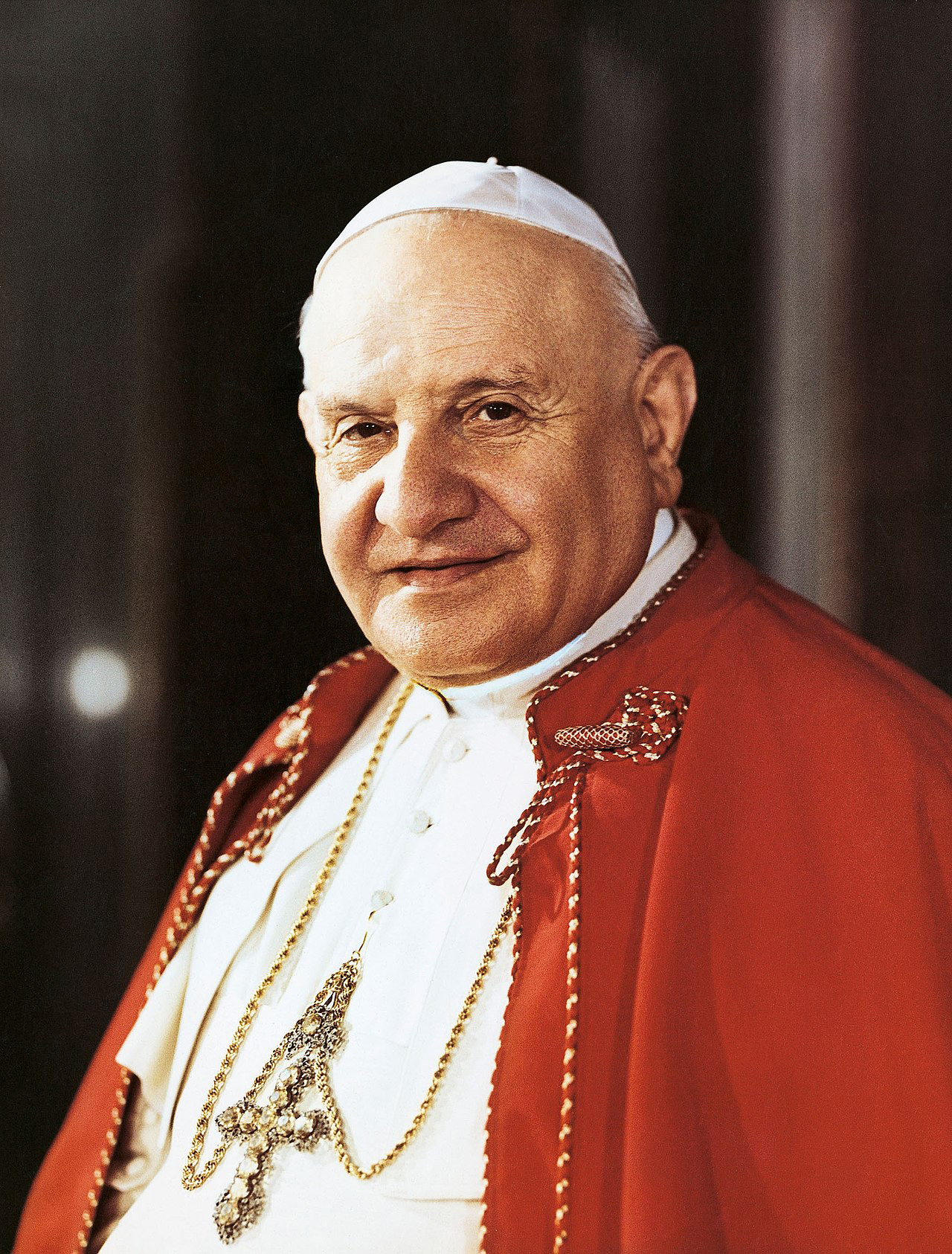
Pope Saint John XXIII was the 261st leader of the Catholic Church and the 21st pope to take the name of John. This article intends to shed light on the man Angelo Roncalli, addressing his life prior to the papacy and any highlights or major accomplishments during his papacy as John XXIII.
Early Life Of Pope John XXIII
Angelo Roncalli was the fourth of Giovanni Roncalli and Marianna Mazzolla’s 13 children and also their eldest son. Like most people living in the village of Sotto il Monte, his family earned a living as sharecroppers. While Angelo was technically of Italian nobility, it came from a poor secondary branch. Roncalli received First Communion and his Confirmation in 1889, at age 8.
Time with the Church.
Roncalli enrolled into the Secular Franciscan order on March 1st, 1896, later becoming a full member on May 23rd, 1897. Roncalli finished his doctorate in Canon Law in 1904, becoming ordained on August 10th of that year. 1905 would see Roncalli become secretary to Bishop Radini-Tedeschi of Bergamo, a position he would maintain until Radini-Tedeschi’s death on Auguust 22nd, 1914. Radini-Tedeschi’s final words to his loyal secretary were that he should pray for peace.
World War I.
Roncalli was drafted into the position of sergeant for the Royal Italian Army, specifically serving within the medical corps as chaplain and stretcher-bearer. Upon his 1919 discharge, Roncalli was declared spiritual director of the seminary.
After World War I.
After meeting with Pope Benedict XV on November 6th, 1921, Roncalli was inducted into the Society for the Propagation of the Faith as its Italian president. In 1925, Roncalli was appointed the Apostolic Visitor to Bulgaria and also Archibishop of Areopolis. November 30th, 1934 would see him become the Apostolic Delegate to Turkey and Greece, as well as the Archibisop of Mesembria, Bulgaria. Roncalli would use his influence to save thousands of refugee Jews throughout Europe.
Roncalli remained in Bulgaria at the time that World War II commenced, optimistically writing in his journal in April 1939, “I don’t believe we will have a war”. At the time that the war did in fact commence, he was in Rome, meeting with Pope Pius XII on 5 September 1939. In 1940, Roncalli was asked by the Vatican to devote more of his time to Greece; therefore, he made several visits there in January and May that year.
Nuncio Roncalli.

December 22nd, 1944 would see Roncalli’s appointment to Apostolic Nuncia of France. This required him to negotiate retirement for several bishops whom had collaborated with the Nazis. In this new role, he used his influence to help anyone, mostly Jewish, fleeing from the Holocaust.
This included delivering immigration certificates to Palestine, producing certificates indicating “baptisms of convenience” and freeing the captives of the Jasenovac and Sered concentration camps, among many other acts.
Cardinal-Priest Roncalli.
January 12, 1953 would see Roncalli’s appointment to Venetian Patriarch and Santa Prisca’s Cardinal-Priest. Vincent Auriol, the President of France, awarded him Commander of the Legion of Honour.
Papal Dealings and Legacy.
Although aware he was a candidate, Roncalli had a return train ticket on his person during the Papal Conclave of 1958-he did not believe he would be chosen. Upon becoming Pope, he was slightly embarrassed at how none of the prepared cassocks suited his 5’2″, 200 pound frame, remarking that he would look horrible on television. He described his first international appearance as “a newborn draped in swaddling clothes.”
One of his first acts was to edit the description of Jews in the Good Friday liturgy; previously, this sermon would describe them as “perfidius,” meaning faithless, and call for their conversion to Catholicism. During confession, he, speaking for the Church, had committed sinful antisemitism for many centuries. During Vatican II, he gave Cardinal Augustin Bea the task of drafting documents engineered toward reconciliation between the Church and the Jewish people.
He believed that the relevance of birth control should be investigated, that divorce flew in the face of church doctrine due to life coming from families, that God is the sole entity able to separate a family and that human rights, even among the elderly and newborn, were universal.
He beatified four people and canonized ten other individuals between the years of 1959 and 1963. He also declared St. Lawrence of Bindisi as “Doctor of the Church” in 1959.
Pope John XXIII Coat of Arms

List of Events in the life of Pope John XXIII (Angelo Roncalli)
| Date | Age | Event | Title |
|---|---|---|---|
| 25 Nov 1881 | Born | ||
| 18 Dec 1903 | 22.0 | Ordained Deacon | Deacon of Bergamo, Italy |
| 10 Aug 1904 | 22.7 | Ordained Priest | Priest of Bergamo, Italy |
| 3 Mar 1925 | 43.2 | Appointed | Titular Archbishop of Areopolis |
| 19 Mar 1925 | 43.3 | Ordained Bishop | Titular Archbishop of Areopolis |
| 19 Mar 1925 | 43.3 | Appointed | Official to Bulgaria |
| 16 Oct 1931 | 49.8 | Appointed | Apostolic Delegate to Bulgaria |
| 30 Nov 1934 | 53.0 | Appointed | Titular Archbishop of Mesembria |
| 30 Nov 1934 | 53.0 | Appointed | Apostolic Delegate to Turkey |
| 30 Nov 1934 | 53.0 | Appointed | Apostolic Delegate to Greece |
| 22 Dec 1944 | 63.0 | Appointed | Apostolic Nuncio to France |
| 12 Jan 1953 | 71.1 | Elevated to Cardinal | |
| 12 Jan 1953 | 71.1 | Resigned | Apostolic Nuncio to France |
| 15 Jan 1953 | 71.1 | Appointed | Patriarch of Venezia {Venice}, Italy |
| 29 Oct 1953 | 71.9 | Appointed | Cardinal-Priest of Santa Prisca |
| 28 Oct 1958 | 76.9 | Elected | Pope (Roma, Italy) |
| 4 Nov 1958 | 76.9 | Installed | Pope (Roma, Italy) |
| 3 Jun 1963 | 81.5 | Died | Pope (Roma, Italy) |
| 3 Sep 2000 | Beatified | ||
| 27 Apr 2014 | Canonized |
Quick Facts about Pope John XXIII.
- He was born on November 25th, 1881.
- He full name prior to ascending to the papacy was Angelo Giuseppe Roncalli.
- He died on June 3rd, 1963
- After developing stomach cancer, he died eight months later of peritonitis. This is when the inner wall of the abdomen becomes inflamed and can cause a variety of unpleasant symptoms. Notably, this is the same illness that befell his late sister Ancilla.
- His papacy began on October 28, 1958.
- Like most, but not all popes, his papacy ended with his death on June 3, 1963.
- Pope Paul VI was elected as his successor.
- The commemorative day for Pope John XXIII is set for October 11, rather than observing it on the anniversary of his passing on June 3. This chosen date marks the significance of October 11, 1962, when the Second Vatican Council first convened.
Five Interesting Facts About Pope John XXIII.
- His papal motto “Oboedientia et Pax” translates as “Obedience and Peace.”
- On 7 September 2000, a campaign was started to acknowledge his righteous efforts aiding the Jewish people.
- After taking his name, there was some confusion as to whether he would be the 23rd or 24th. After affirming he was John XXIII, the previous John XXIII, who opposed Gregory XII, was classified as an “antipope.”
- Turkish Muslims gave him the nickname “the Turcophile Pope” for his influence in their country.
- His inability to visit his dying mother and a sister due to the Church obligations inspired him to seek burial with his predecessors instead of his family in Sotto il Monte.
- He was beatified on 3 September 2000 by Pope John Paul II
- Pope John XXIII was canonized (made a saint) on 27th April 2014 at Saint Peter’s Square, Vatican City by Pope Francis, on the 50th anniversary of his death.

All of the Popes that took the name “John”
There has been 21 popes that have taken the name of John.
John I (St.) (#53) (523 – 526)
John II (#56) (533 – 535)
John III (#61) (561 – 574)
John IV (#72) (640 – 642)
John V (#82) (685 – 686)
John VI (#85) (701 – 705)
John VII (#86) (705 – 707)
John VIII (#108) (872 – 882)
John IX (#117) (898 – 900)
John X (#123) (914 – 928)
John XI (#126) (931 – 935)
John XII (#131) (955 – 963)
John XIII (#134) (965 – 972)
John XIV (#137) (983 – 984)
John XV (#138) (985 – 996)
John XVII (#141) (1003)
John XVIII (#142) (1003 – 1009)
John XIX (#145) (1024 – 1032)
John XXI (#188) (1276 – 1277)
John XXII (#197) (1316 – 1334)
John XXIII (Blessed) (#262) (1958 – 1963)